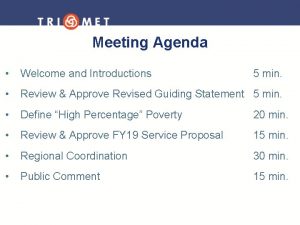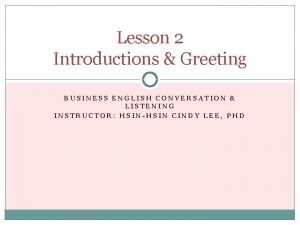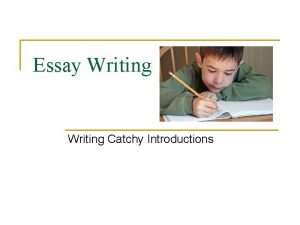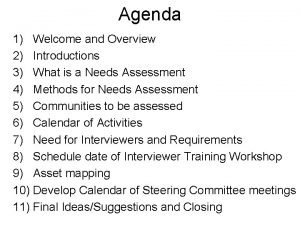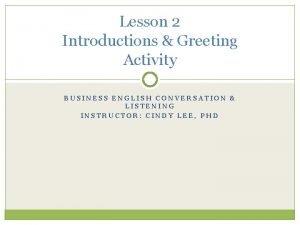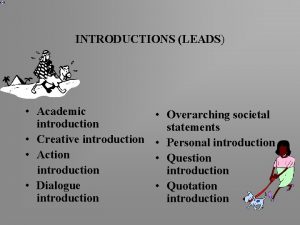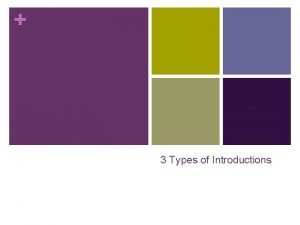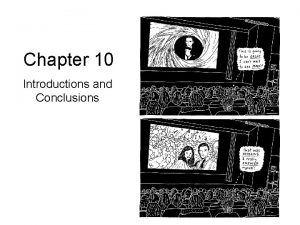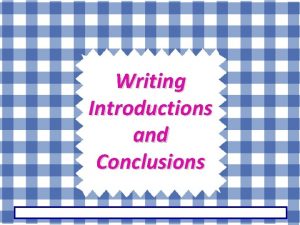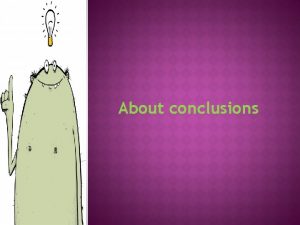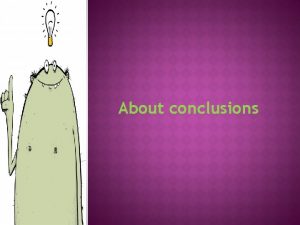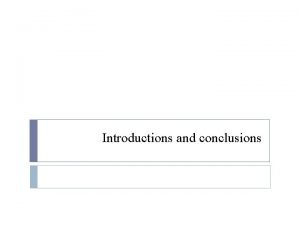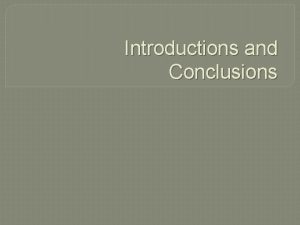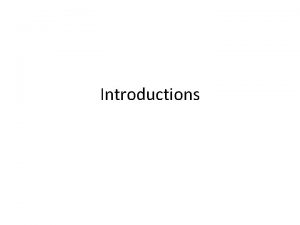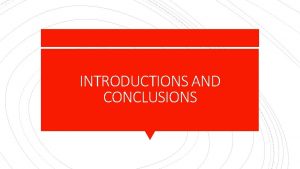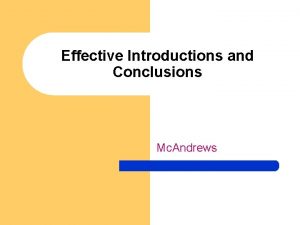Chapter 9 Introductions Conclusions Your Aim for an













- Slides: 13

Chapter 9 Introductions & Conclusions

Your Aim for an Effective Introduction and Conclusion: • Introductions: • A. • B. • Create a Favorable First Impression Self-confidence is built with a Solid Intro. Conclusion: • A. • B. One Last chance to Emphasize Main Points Creates Favorable Final Impression

I. INTRODUCTIONS • Four Elements in an Introduction are: • 1. Gain Attention/Interest of Audience (Intro self) • 2. Reveal the Topic • 3. Establish Credibility & Good Will of Speaker • 4. Preview the Body (Main Points) of Speech

1. Eight ways to Gain Attention & Interest • 1. Relate the topic to the Audience • 2. State the Importance of Topic • 3. You could Startle the Audience • 4. Arouse Curiosity • 5. Use a Question • 6. Quotation • 7. Tell a Story / Testimonial • 8. Other: Participation, volunteer, drama, visual aid, relate to previous speech


II. Reveal the Topic • 1. Clearly state topic to avoid confusing audience • 2. Even in the case of a demonstration speech where items are visible

III. Establish Your Credibility & Good Will • 1. Audience sees credible speakers: appearance • 2. Whatever your qualifications, let them know • “After • conducting research. . . ” “With my experience. . . ” 3. Good Will shows audience you have their best interest in mind. • “I would like to discuss (to assist) you in being better prepared for earthquakes” •

IV. Preview the Main Points (Body) of Speech • 1. Preview (state) all main points you will discuss. It tells Audience what to listen for and expect. • 2. Provides a smooth transition into Body of speech • 3. Provides opportunity, if needed, to list definitions of terms or concepts you will be using

Five Tips to Follow when Preparing an Introduction • 1. Be Relatively Brief • 2. When researching, Keep a Lookout for interesting material • 3. Be Creative (refer to “gaining attentions” material) • 4. You will possibly “Fine-Tune” your intro after the Body of your speech is finished • 5. You should Memorize the Intro. Know it well so your delivery will be effective: strong eye contact and confident delivery

II. CONCLUSIONS Conclusions have Two Functions: I. Signals the End of the speech A. Abrupt endings leave listeners surprised and unfulfilled. B. You may signal by saying, “In conclusion. . . ” or “One last thought. . . ” C. Your style of delivery or body language could be another signal.

Two Functions cont. 2. Reinforces Understanding/Commitment of the Central Idea A. Summarize Main Points B. Conclude with a Quotation C. End with a Dramatic Statement D. Refer Back to Intro: story, quote etc.

Two Functions cont. Four Tips to Follow in Conclusion Prep: 1. Look for closing material when researching 2. Conclude with a Bang, instead of whimper. DON’T APOLOGIZE 3. Don’t be long-winded. NEVER pick up forgotten items or ideas 4. Needs to be memorable, take special care to prepare conclusion -end-

 Grabber in essay
Grabber in essay Meeting agenda welcome and introductions
Meeting agenda welcome and introductions Agenda welcome and introductions
Agenda welcome and introductions Listening greeting conversation
Listening greeting conversation Introductions for persuasive essays
Introductions for persuasive essays German greetings and introductions
German greetings and introductions Survey introductions
Survey introductions Catchy introductions
Catchy introductions Agenda welcome and introductions
Agenda welcome and introductions Meeting agenda welcome and introductions
Meeting agenda welcome and introductions Business english conversation
Business english conversation Creative introductions
Creative introductions Interrogative introduction
Interrogative introduction Agenda welcome and introductions
Agenda welcome and introductions

